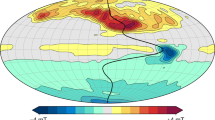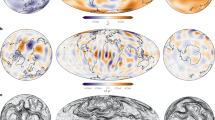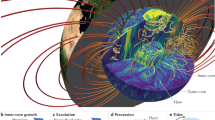Abstract
Observations of the change in Earth’s magnetic field—the secular variation—provide information about the motion of liquid metal within the core that is responsible for the magnetic field’s generation. High-resolution observations from the European Space Agency’s Swarm satellite mission show intense field change at high latitude, localized in a distinctive circular daisy-chain configuration centred on the north geographic pole. Here we show that this feature can be explained by a localized, non-axisymmetric, westward jet of 420 km width on the tangent cylinder, the cylinder of fluid within the core that is aligned with the rotation axis and tangent to the solid inner core. We find that the jet has increased in magnitude by a factor of three over the period 2000–2016 to about 40 km yr−1, and is now much stronger than typical large-scale flows inferred for the core. We suggest that the current accelerating phase may be part of a longer-term fluctuation of the jet causing both eastward and westward movement of magnetic features over historical periods, and may contribute to recent changes in torsional-wave activity and the rotation direction of the inner core.
This is a preview of subscription content, access via your institution
Access options
Subscribe to this journal
Receive 12 print issues and online access
$259.00 per year
only $21.58 per issue
Buy this article
- Purchase on Springer Link
- Instant access to full article PDF
Prices may be subject to local taxes which are calculated during checkout





Similar content being viewed by others
References
Finlay, C. C., Olsen, N., Kotsiaros, S., Gillet, N. & Toeffner-Clausen, L. Recent geomagnetic secular variation from Swarm and ground observatories as estimated in the CHAOS-6 geomagnetic field model. Earth Planets Space 68, 1–18 (2016).
Gillet, N., Jault, D., Finlay, C. C. & Olsen, N. Stochastic modeling of the Earth’s magnetic field: inversion for covariances over the observatory era. Geochem. Geophys. Geosyst. 14, 766–786 (2013).
Jackson, A., Jonkers, A. R. T. & Walker, M. R. Four centuries of geomagnetic secular variation from historical records. Phil. Trans. R. Soc. Lond. A 358, 957–990 (2000).
Korte, M., Constable, C., Donadini, F. & Holme, R. Reconstructing the Holocene geomagnetic field. Earth Planet. Sci. Lett. 312, 497–505 (2011).
Bloxham, J. & Gubbins, D. The secular variation of Earth’s magnetic field. Nature 317, 777–781 (1985).
Korte, M. & Holme, R. On the persistence of geomagnetic flux lobes in global Holocene field models. Phys. Earth Planet. Int. 182, 179–186 (2010).
Olsen, N. et al. The CHAOS-4 geomagnetic field model. Geophys. J. Int. 197, 815–827 (2014).
Hulot, G., Eymin, C., Langlais, B., Mandea, M. & Olsen, N. Small-scale structure of the geodynamo inferred from Ørsted and Magsat data. Nature 416, 620–623 (2002).
Finlay, C. C. & Jackson, A. Equatorially dominated magnetic field change at the surface of Earth’s core. Science 300, 2084–2086 (2003).
Chulliat, A., Hulot, G. & Newitt, L. R. Magnetic flux expulsion from the core as a possible cause of the unusually large acceleration of the north magnetic pole during the 1990s. J. Geophys. Res. 115, B07101 (2010).
Lawrence, K. et al. Paleomagnetic field properties at high southern latitude. Geochem. Geophys. Geosyst. 10, Q01005 (2009).
Bloxham, J., Gubbins, D. & Jackson, A. Geomagnetic secular variation. Phil. Trans. R. Soc. Lond. A 329, 415–502 (1989).
Hide, R. Free hydromagnetic oscillations of the Earth’s core and the theory of geomagnetic secular variation. Phil. Trans. R. Soc. Lond. A 259, 615–647 (1966).
Aurnou, J., Andreadis, S., Zhu, L. & Olson, P. Experiments on convection in Earth’s core tangent cylinder. Earth Planet. Sci. Lett. 212, 119–134 (2003).
Hollerbach, R. & Proctor, M. R. E. in Solar and Planetary Dynamos (eds Proctor, M. R. E. et al.) 145–152 (Cambridge Univ. Press, 1993).
Livermore, P. & Hollerbach, R. Successive elimination of shear layers by a hierarchy of constraints in inviscid spherical-shell flows. J. Math. Phys. 53, 073104 (2012).
Taylor, J. B. The magneto-hydrodynamics of a rotating fluid and the Earth’s dynamo problem. Proc. R. Soc. A 9, 274–283 (1963).
Sheyko, A., Finlay, C. C. & Jackson, A. Magnetic reversals from planetary dynamo waves. Nature 539, 551–554 (2016).
Livermore, P. W., Hollerbach, R. & Jackson, A. Electromagnetically driven westward drift and inner-core superrotation in Earth’s core. Proc. Natl Acad. Sci. USA 110, 15914–15918 (2013).
Labbé, F., Jault, D. & Gillet, N. On magnetostrophic inertia-less waves in quasi-geostrophic models of planetary cores. Geophys. Astrophys. Fluid Dynam. 109, 587–610 (2015).
Holme, R. in Treatise on Geophysics Vol. 8 (ed. Kono, M.) 91–113 (Elsevier, 2015).
Pais, A. & Jault, D. Quasi-geostrophic flows responsible for the secular variation of the Earth’s magnetic field. Geophys. J. Int. 173, 421–443 (2008).
Baerenzung, J., Holschneider, M. & Lesur, V. The flow at the Earth’s core mantle boundary under weak prior constraints. J. Geophys. Res. 121, 1343–1364 (2016).
Olson, P. & Aurnou, J. M. A polar vortex in the Earth’s core. Nature 402, 170–173 (1999).
Aubert, J., Finlay, C. C. & Fournier, A. Bottom-up control of geomagnetic secular variation by the Earth’s inner core. Nature 502, 219–223 (2013).
Jackson, A. Intense equatorial flux spots on the surface of the Earth’s core. Phys. Earth Planet. Inter. 424, 760–763 (2003).
Dumberry, M. & Finlay, C. C. Eastward and westward drift of the Earth’s magnetic field for the last three millennia. Earth Planet. Sci. Lett. 254, 146–157 (2007).
Davies, C., Pozzo, M., Gubbins, D. & Alfè, D. Constraints from material properties on the dynamics and evolution of Earth’s core. Nature Geosci. 8, 678–685 (2015).
Tkalc̆ić, H., Young, M., Bodin, T., Ngo, S. & Sambridge, M. The shuffling rotation of the Earth’s inner core revealed by earthquake doublets. Nature Geosci. 6, 497–502 (2013).
Gillet, N., Jault, D., Canet, E. & Fournier, A. Fast torsional waves and strong magnetic field within the Earth’s core. Nature 465, 74–77 (2010).
Teed, R. J., Jones, C. A. & Tobias, S. M. The transition to Earth-like torsional oscillations in magnetoconvection simulations. Earth Planet. Sci. Lett. 419, 22–31 (2015).
Gillet, N., Jault, D. & Finlay, C. C. Planetary gyre, time-dependent eddies, torsional waves, and equatorial jets at the Earth’s core surface. J. Geophys. Res. 120, 3991–4013 (2015).
Hunter, J. D. Matplotlib: a 2D graphics environment. Comput. Sci. Eng. 9, 90–95 (2007).
Thébault, E. et al. Evaluation of candidate geomagnetic field models for IGRF-12. Earth Planets Space 67, 112 (2015).
Sabaka, T. J., Olsen, N., Tyler, R. H. & Kuvshinov, A. CM5, a pre-Swarm comprehensive geomagnetic field model derived from over 12 yr of CHAMP, Ørsted, SAC-C and observatory data. Geophys. J. Int. 200, 1596–1626 (2015).
Lesur, V., Wardinski, I., Rother, M. & Mandea, M. GRIMM: the GFZ reference internal magnetic model based on vector satellite and observatory data. Geophys. J. Int. 173, 382–394 (2008).
Lesur, V., Wardinski, I., Hamoudi, M. & Rother, M. The second generation of the GFZ reference internal magnetic model: GRIMM-2. Earth Planets Space 62, 765–773 (2010).
Olsen, N. et al. The Swarm initial field model for the 2014 geomagnetic field. Geophys. Res. Lett. 42, 1092–1098 (2015).
Olsen, N. et al. The Swarm satellite constellation application and research facility (SCARF) and Swarm data products. Earth Planets Space 65, 1189–1200 (2013).
Maus, S., Manoj, C., Rauberg, J., Michaelis, I. & Lühr, H. NOAA/NGDC candidate models for the 11th generation International Geomagnetic Reference Field and the concurrent release of the 6th generation Pomme magnetic model. Earth Planets Space 62, 729–735 (2010).
Acknowledgements
Swarm data used in the construction of the magnetic field models were provided by the European Space Agency. The support of the CHAMP mission by the German Aerospace Center (DLR) and the Federal Ministry of Education and Research is gratefully acknowledged. The staff of the geomagnetic observatories and INTERMAGNET are thanked for supplying high-quality observatory data. The deep-Earth research group within the School of Earth and Environment, University of Leeds, is thanked for comments and discussion on an early version of this manuscript. The figures were produced using the Python package Matplotlib33. The authors would like to thank R. Holme and I. Wardinski for constructive comments that helped improve the manuscript. P.W.L. was partially supported by the NERC grant NE/G014043/1.
Author information
Authors and Affiliations
Contributions
All authors contributed to the design and rationale of this work. C.C.F. provided and commented on the observational field models; P.W.L. and R.H. devised the numerical scheme. P.W.L. performed the calculations and wrote the paper, on which all authors commented.
Corresponding author
Ethics declarations
Competing interests
The authors declare no competing financial interests.
Supplementary information
Supplementary Information
(PDF 1743 kb)
Supplementary Movies
(MOV 1162 kb)
Supplementary Movies
(MOV 1159 kb)
Supplementary Movies
(MOV 2266 kb)
Rights and permissions
About this article
Cite this article
Livermore, P., Hollerbach, R. & Finlay, C. An accelerating high-latitude jet in Earth’s core. Nature Geosci 10, 62–68 (2017). https://doi.org/10.1038/ngeo2859
Received:
Accepted:
Published:
Issue Date:
DOI: https://doi.org/10.1038/ngeo2859
This article is cited by
-
Gyres, jets and waves in the Earth’s core
Nature Reviews Earth & Environment (2023)
-
Rapid Variations of Earth’s Core Magnetic Field
Surveys in Geophysics (2022)
-
Waves in planetary dynamos
Reviews of Modern Plasma Physics (2022)
-
A Dynamical Prospective on Interannual Geomagnetic Field Changes
Surveys in Geophysics (2022)
-
Variability of Ionospheric Plasma: Results from the ESA Swarm Mission
Space Science Reviews (2022)



